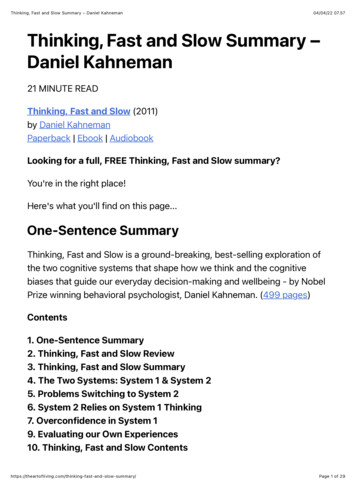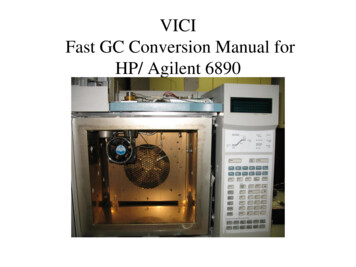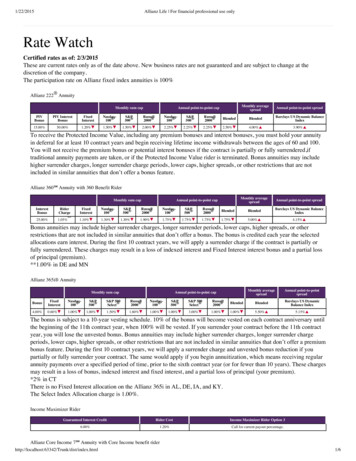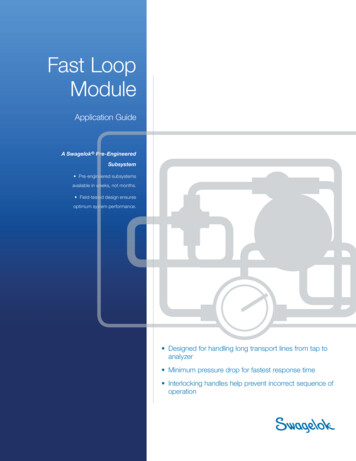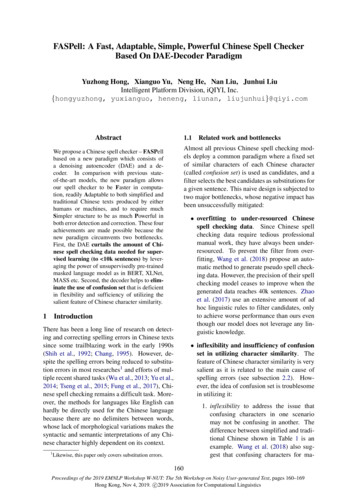
Transcription
FASPell: A Fast, Adaptable, Simple, Powerful Chinese Spell CheckerBased On DAE-Decoder ParadigmYuzhong Hong, Xianguo Yu, Neng He, Nan Liu, Junhui LiuIntelligent Platform Division, iQIYI, Inc.{hongyuzhong, yuxianguo, heneng, liunan, liujunhui}@qiyi.comAbstract1.1Almost all previous Chinese spell checking models deploy a common paradigm where a fixed setof similar characters of each Chinese character(called confusion set) is used as candidates, and afilter selects the best candidates as substitutions fora given sentence. This naive design is subjected totwo major bottlenecks, whose negative impact hasbeen unsuccessfully mitigated:We propose a Chinese spell checker – FASPellbased on a new paradigm which consists ofa denoising autoencoder (DAE) and a decoder. In comparison with previous stateof-the-art models, the new paradigm allowsour spell checker to be Faster in computation, readily Adaptable to both simplified andtraditional Chinese texts produced by eitherhumans or machines, and to require muchSimpler structure to be as much Powerful inboth error detection and correction. These fourachievements are made possible because thenew paradigm circumvents two bottlenecks.First, the DAE curtails the amount of Chinese spell checking data needed for supervised learning (to 10k sentences) by leveraging the power of unsupervisedly pre-trainedmasked language model as in BERT, XLNet,MASS etc. Second, the decoder helps to eliminate the use of confusion set that is deficientin flexibility and sufficiency of utilizing thesalient feature of Chinese character similarity.1 overfitting to under-resourced Chinesespell checking data. Since Chinese spellchecking data require tedious professionalmanual work, they have always been underresourced. To prevent the filter from overfitting, Wang et al. (2018) propose an automatic method to generate pseudo spell checking data. However, the precision of their spellchecking model ceases to improve when thegenerated data reaches 40k sentences. Zhaoet al. (2017) use an extensive amount of adhoc linguistic rules to filter candidates, onlyto achieve worse performance than ours eventhough our model does not leverage any linguistic knowledge.IntroductionThere has been a long line of research on detecting and correcting spelling errors in Chinese textssince some trailblazing work in the early 1990s(Shih et al., 1992; Chang, 1995). However, despite the spelling errors being reduced to substitution errors in most researches1 and efforts of multiple recent shared tasks (Wu et al., 2013; Yu et al.,2014; Tseng et al., 2015; Fung et al., 2017), Chinese spell checking remains a difficult task. Moreover, the methods for languages like English canhardly be directly used for the Chinese languagebecause there are no delimiters between words,whose lack of morphological variations makes thesyntactic and semantic interpretations of any Chinese character highly dependent on its context.1Related work and bottlenecks inflexibility and insufficiency of confusionset in utilizing character similarity. Thefeature of Chinese character similarity is verysalient as it is related to the main cause ofspelling errors (see subsection 2.2). However, the idea of confusion set is troublesomein utilizing it:1. inflexibility to address the issue thatconfusing characters in one scenariomay not be confusing in another. Thedifference between simplified and traditional Chinese shown in Table 1 is anexample. Wang et al. (2018) also suggest that confusing characters for ma-Likewise, this paper only covers substitution errors.160Proceedings of the 2019 EMNLP Workshop W-NUT: The 5th Workshop on Noisy User-generated Text, pages 160–169Hong Kong, Nov 4, 2019. c 2019 Association for Computational Linguistics
chines are different from those for humans. Therefore, in practice, it is verylikely that the correct candidates for substitution do not exist in a given confusion set, which harms recall. Also, considering more similar characters to preserve recall will risk lowering precision.2. insufficiency in utilizing character similarity. Since a cut-off threshold of quantified character similarity (Liu et al.,2010; Wang et al., 2018) is used to produce the confusion set, similar characters are actually treated indiscriminatelyin terms of their similarity. This meansthe information of character similarityis not sufficiently utilized. To compensate this, Zhang et al. (2015) propose aspell checker that has to consider manyless salient features such as word segmentation, which add more unnecessarynoises to their model.1.22. The DAE-decoder paradigm is sequenceto-sequence, which makes it resemble theencoder-decoder paradigm in tasks like machine translation, grammar checking, etc.However, in the encoder-decoder paradigm,the encoder extracts semantic information,and the decoder generates texts that embodythe information. In contrast, in the DAEdecoder paradigm, the DAE provides candidates to reconstruct texts from the corruptedones based on contextual feature, and the decoder3 selects the best candidates by incorporating other features.Besides the new paradigm per se, there are twoadditional contributions in our proposed Chinesespell checking model: we propose a more precise quantificationmethod of character similarity than the onesproposed by Liu et al. (2010) and Wang et al.(2018) (see subsection 2.2); we propose an empirically effective decoderto filter candidates under the principle of getting the highest possible precision with minimal harm to recall (see subsection 2.3).Motivation and contributionsThe motivation of this paper is to circumvent thetwo bottlenecks in subsection 1.1 by changing theparadigm for Chinese spell checking.As a major contribution and as exemplified byour proposed Chinese spell checking model in Figure 1, the most general form of the new paradigmconsists of a denoising autoencoder2 (DAE) and adecoder. To prove that it is indeed a novel contribution, we compare it with two similar paradigmsand show their differences as follows:1.3AchievementsThanks to our contributions mentioned in subsection 1.2, our model can be characterized by the following achievements relative to previous state-ofthe-art models, and thus is named FASPell. Our model is Fast. It is shown (subsection3.3) to be faster in filtering than previousstate-of-the-art models either in terms of absolute time consumption or time complexity.1. Similar to the old paradigm used in previousChinese spell checking models, a model under the DAE-decoder paradigm also producescandidates (by DAE) and then filters the candidates (by the decoder). However, candidates are produced on the fly based on contexts. If the DAE is powerful enough, weshould expect that all contextually suitablecandidates are recalled, which prevent the inflexibility issue caused by using confusionset. The DAE will also prevent the overfitting issue because it can be trained unsupervisedly using a large number of natural texts.Moreover, character similarity can be used bythe decoder without losing any information. Our model is Adaptable. To demonstrate this,we test it on texts from different scenarios– texts by humans, such as learners of Chinese as a Foreign Language (CFL), and bymachines, such as Optical Character Recognition (OCR). It can also be applied to bothsimplified Chinese and traditional Chinese,despite the challenging issue that some erroneous usages of characters in traditionaltexts are considered valid usages in simplified texts (see Table 1). To the best of ourknowledge, all previous state-of-the-art models only focus on human errors in traditionalChinese texts.2the term denoising autoencoder follows the same senseused by Yang et al. (2019), which is arguably more generalthan the one used by Vincent et al. (2008).3The term decoder here is analogous as in Viterbi decoderin the sense of finding the best path along candidates.161
Table 1: Examples on the left are considered validusages in simplified Chinese (SC). Notes on the rightare about how they are erroneous in traditional Chinese (TC) and suggested corrections. This inconsistency is because multiple traditional characters weremerged into identical characters in the simplificationprocess. Our model makes corrections for this type oferrors only in traditional texts. In simplified texts, theyare not detected as errors.SC ExamplesNotes on TC usage周末 (weekend)旅游 (trip)制造 (make)周 週 周 only in 周到, etc.游 遊 游 only in 游泳, etc.制 製 制 only in 制度, etc.Confidence-Similarity Decoderrank 1國 際 听 话 著 音 广 目 者rank 2世 家 节 视 报 台 演 主 手rank 3界 讲 播 冠 闻 支 节 持台 nk 00.00000.0000Masked Language Model国 际 电 台 苦 名 丰 持 人 Figure 1: A real example of how an erroneous sentencewhich is supposed to have the meaning of "A famousinternational radio broadcaster" is successfully spellchecked with two erroneous characters 苦 and 丰 beingdetected and corrected using FASPell. Note that withour proposed confidence-similarity decoder, the finalchoice for substitution is not necessarily the candidateranked the first. Our model is Powerful. On benchmarkdata sets, it achieves similar F1 performances(subsection 3.2) to those of previous state-ofthe-art models on both detection and correction level. It also achieves arguably high precision (78.5% in detection and 73.4% in correction) on our OCR data set.time, a random token in the vocabulary 10% ofthe time and the original token 10% of the time. Incases where a random token is used as the mask,the model actually learns how to correct an erroneous character; in cases where the original tokensare kept, the model actually learns how to detect ifa character is erroneous or not. For simplicity purposes, FASPell adopts the architecture of MLM asin BERT (Devlin et al., 2018). Recent variants –XLNet (Yang et al., 2019), MASS (Song et al.,2019) have more complex architectures of MLM,but they are also suitable.However, just using a pre-trained MLM raisesthe issue that the errors introduced by randommasks may be very different from the actual errorsin spell checking data. Therefore, we propose thefollowing method to fine-tune the MLM on spellchecking training sets:FASPellAs shown in Figure 1, our model uses masked language model (see subsection 2.1) as the DAE toproduce candidates and confidence-similarity decoder (see subsection 2.2 and 2.3) to filter candidates. In practice, doing several rounds of thewhole process is also proven to be helpful (subsection 3.4).2.1国 际 电 台 知 名 主 持 人0.9994 Our model is Simple. As shown in Figure 1, it has only a masked language modeland a filter as opposed to multiple featureproducing models and filters being used inprevious state-of-the-art proposals. Moreover, only a small training set and a set ofvisual and phonological features of characters are required in our model. No extra dataare necessary, including confusion set. Thismakes our model even simpler.2 国 际 电 台 著 名 主 持 人Masked language modelMasked language model (MLM) guesses the tokens that are masked in a tokenized sentence. Itis intuitive to use MLM as the DAE to detect andcorrect Chinese spelling errors because it is in linewith the task of Chinese spell checking. In theoriginal training process of MLM in BERT (Devlin et al., 2018), the errors are the random masks,which are the special token [MASK] 80% of the For texts that have no errors, we follow theoriginal training process as in BERT; For texts that have errors, we create two typesof training examples by:162
1. given a sentence, we mask the erroneoustokens with themselves and set their target labels as their corresponding correctcharacters;2. to prevent overfitting, we also mask tokens that are not erroneous with themselves and set their target labels as themselves, too.贫 : 丿乁 𠃌丿 丨𠃌 ----- ② ①/\ /\贝分/" /"刀 冂人八 /\③ The two types of training examples are balanced to have roughly similar quantity. 丿/\ 乁 𠃌 丿丨 𠃌 丿乁Figure 2: The IDS of a character can be given in different granularity levels as shown in the tree forms in - for the simplified character 贫 (meaning poor).In FASPell, we only use stroke-level IDS in the formof a string, like the one above the dashed ruling line.Unlike using only actual strokes (Wang et al., 2018),the Unicode standard Ideographic Description Characters (e.g., the non-leaf nodes in the trees) describe thelayout of a character. They help us to model the subtle nuances in different characters that are composed ofidentical strokes (see examples in Table 2). Therefore,IDS gives us a more precise shape representation of acharacter.In our model, we only adopt the string-formIDS. We define the visual similarity between twocharacters as one minus normalized6 Levenshteinedit distance between their IDS representations.The reason for normalization is twofold. Firstly,we want the similarity to range from 0 to 1 for theconvenience of later filtering. Secondly, if a pairof more complex characters have the same edit distance as a pair of less complex characters, we wantthe similarity of the more complex characters to beslightly higher than that of the less complex characters (see examples in Table 2).We do not use the tree-form IDS for two reasons even as it seems to make more sense intuitively. Firstly, even with the most efficient algorithm (Pawlik and Augsten, 2015, 2016) so far, treeedit distance (TED) has far greater time complexity than edit distance of strings (O(mn(m n))vs. O(mn)). Secondly, we did try TED in preliminary experiments, but there was no significant difference from using edit distance of strings in termsof spell checking performance.Character similarityErroneous characters in Chinese texts by humansare usually either visually (subsection 2.2.1) orphonologically similar (subsection 2.2.2) to corresponding correct characters, or both (Chang, 1995;Liu et al., 2010; Yu and Li, 2014). It is also truethat erroneous characters produced by OCR possess visual similarity (Tong and Evans, 1996).We base our similarity computation on twoopen databases: Kanji Database Project4 and Unihan Database5 because they provide shape andpronunciation representations for all CJK UnifiedIdeographs in all CJK languages.2.2.1 /"/\/"/"Fine-tuning a pre-trained MLM is proven to bevery effective in many downstream tasks (Devlinet al., 2018; Yang et al., 2019; Song et al., 2019),so one would argue that this is where the power ofFASPell mainly comes from. However, we wouldlike to emphasize that the power of FASPell shouldnot be biasedly attributed to MLM. In fact, weshow in our ablation studies (subsection 3.2) thatMLM itself can only serve as a very weak Chinesespell checker (its performance can be as poor asF1 being only 28.9%), and the decoder that utilizes character similarity (see subsection 2.2 and2.3) is also significantly indispensable to producing a strong Chinese spell checker.2.2/\Visual similarityThe Kanji Database Project uses the Unicodestandard – Ideographic Description Sequence(IDS) to represent the shape of a character.As illustrated by examples in Figure 2, the IDSof a character is formally a string, but it is essentially the preorder traversal path of an ordered ://unicode.org/charts/unihan.html6Since the maximal value of Levenshtein edit distance isthe maximum of the lengths of the two strings in question, wenormalize it simply by dividing it by the maximum length.163
Table 2: Examples of the computation of character similarities. IDS is used to compute visual similarity (V-sim)and pronunciation representations in Mandarin Chinese (MC), Cantonese Chinese (CC), Japanese On’yomi (JO),Korean (K) and Vietnamese (V) are used to compute phonological similarity (P-sim). Note that the normalizationof edit distance gives us the desired fact that less complex character pair (午, 牛) has smaller visual similarity thanmore complex character pair (田, 由) even though both of their IDS edit distances are 1. Also, note that 午 and牛 have more similar pronunciations in some languages than in others; the combination of the pronunciations inmultiple languages gives us a more continuous phonological similarity.IDS2.2.2午 (noon)牛 (cow) 丿一 一丨田 (field)由 (from) 丨𠃌 一丨一 丿一 一丨 丨𠃌 一丨一MCCCwu3niu2tian2you2VV-simP-simng5 goongau4 gyuu honological similaritydenyuuKcenyuthe original characters. For those that are different, we can draw a confidence-similarity scatter graph. If we compare the candidates with theground truths, the graph will resemble the plot of Figure 3. We can observe that the truedetection-and-correction candidates are denser toward the upper-right corner; false-detection candidates toward the lower-left corner; true-detectionand-false-correction candidates in the middle area.If we draw a curve to filter out false-detectioncandidates (plot of Figure 3) and use the restas substitutions, we can optimize character-levelprecision with minimal harm to character-levelrecall for detection; if true-detection-and-falsecorrection candidates are also filtered out (plot of Figure 3), we can get the same effect for correction. In FASPell, we optimize correction performance and manually find the filtering curve using a training set, assuming its consistency with itscorresponding testing set. But in practice, we haveto find two curves – one for each type of similarity,and then take the union of the filtering results.Now, consider the case where there are c 1candidates. To reduce it into the previously described simplest case, we rank the candidates foreach original character according to their contextual confidence and put candidates that have thesame rank into the same group (i.e., c groups intotal). Thus, we can find a filter as previously described for each group of candidates. All c filterscombined further alleviate the harm to recall because more candidates are taken into account.In the example of Figure 1, there are c 4groups of candidates. We get a correct substitution丰 主 from the group whose rank 1, anotherone 苦 著 from the group whose rank 2, andno more from the other two groups.Different Chinese characters sharing identical pronunciation is very common (Yang et al., 2012),which is the case for any CJK language. Thus, Ifwe were to use character pronunciations in onlyone CJK language, the phonological similarity ofcharacter pairs would be limited to a few discretevalues. However, a more continuous phonological similarity is preferred because it can make thecurve used for filtering candidates smoother (seesubsection 2.3).Therefore, we utilize character pronunciationsof all CJK languages (see examples in Table 2),which are provided by the Unihan Database. Tocompute the phonological similarity of two characters, we first calculate one minus normalizedLevenshtein edit distance between their pronunciation representations in all CJK languages (if applicable). Then, we take the mean of the results.Hence, the similarity should range from 0 to 1.2.3JOConfidence-Similarity DecoderCandidate filters in many previous models arebased on setting various thresholds and weights formultiple features of candidate characters. Insteadof this naive approach, we propose a method thatis empirically effective under the principle of getting the highest possible precision with minimalharm to recall. Since the decoder utilizes contextual confidence and character similarity, we referto it as the confidence-similarity decoder (CSD).The mechanism of CSD is explained, and its effectiveness is justified as follows:First, consider the simplest case where only onecandidate character is provided for each originalcharacter. For those candidates that are the sameas their original characters, we do not substitute164
40.2filtering onfidence 0.810.81 denceFigure 3: All four plots show the same confidence-similarity graph of candidates categorized by being truedetection-and-true-correction (T-d&T-c), true-detection-and-false-correction (T-d&F-c) and false-detection (F-d).But, each plot shows a different way of filtering candidates: in plot , no candidates are filtered; in plot , thefiltering optimizes detection performance; in plot , as adopted in FASPell, the filtering optimizes correctionperformance; in plot , as adopted by previous models, candidates are filtered out by setting a threshold forweighted confidence and similarity (0.8 conf idence 0.2 similarity 0.8 as an example in the plot). Notethat the four plots use the actual first-rank candidates (using visual similarity) for our OCR data (T rnocr ) exceptthat we randomly sampled only 30% of the candidates to make the plots more viewable on paper.3Table 3: Statistics of datasets.Experiments and resultsWe first describe the data, metrics and model configurations adopted in our experiments in subsection 3.1. Then, in subsection 3.2, we show the performance on spell checking texts written by humans to compare FASPell with previous state-ofthe-art models; we also show the performance ondata that are harvested from OCR results to provethe adaptability of the model. In subsection 3.3,we compare the speed of FASPell and three stateof-the-art models. In subsection 3.4, we investigate how hyper-parameters affect the performanceof FASPell.3.1Dataset# erroneous sent# sentAvg. lengthT rn13T rn14T rn15T st13T st14T 849.631.374.350.030.6T rnocrT stocr357510003575100010.110.2recall and F1 given by SIGHAN13 - 15 sharedtasks on Chinese spell checking (Wu et al., 2013;Yu et al., 2014; Tseng et al., 2015). We also harvested 4575 sentences (4516 are simplified Chinese) from OCR results of Chinese subtitles invideos. We used the OCR method by Shi et al.(2017). Detailed data statistics are in Table 3.Data, metrics and configurationsWe adopt the benchmark datasets (all in traditionalChinese) and sentence-level7 accuracy, precision,7Note that although we do not use character-level metrics(Fung et al., 2017) in evaluation, they are actually importantin the justification of the effectiveness of the CSD as in subsection 2.3We use the pre-trained masked language165
Table 5: Speed comparison (ms/sent). Note that thespeed of FASPell is the average in several rounds.Table 4: Configurations of FASPell. FT means thetraining set for fine-tuning; CSD means the training setfor CSD; r means the number of rounds and c meansthe number of candidates for each character. U is theunion of all the spell checking data from SIGHAN13 15.FTTest setrcU T st13 T rn13U T st14 T rn14U T st15 T rn15T st13T st14T st1513344410k10k10kT rnocrT stocr24(-)(-)CSDFT stepsFASPellWang et al. (2018)T st13T st14T st15446284177680745566derlying principle of the design of CSD.3.3model8 provided by Devlin et al. (2018). Settings of its hyper-parameters and pre-trainingare available at https://github.com/google-research/bert. Other configurations of FASPell used in our major experiments(subsection 3.2 - 3.3) are given in Table 4. Forablation experiments, the same configurations areused except when CSD is removed, we take thecandidates ranked the first as default outputs. Notethat we do not fine-tune the mask language modelfor OCR data because we learned in preliminaryexperiments that fine-tuning worsens performancefor this type of data9 .3.2Test setFiltering Speed10First, we measure the filtering speed of Chinesespell checking in terms of absolute time consumption per sentence (see Table 5). We compare thespeed of FASPell with the model by Wang et al.(2018) in this manner because they have reportedtheir absolute time consumption11 . Table 5 clearlyshows that FASPell is much faster.Second, to compare FASPell with models(Zhang et al., 2015; Zhao et al., 2017) whose absolute time consumption has not been reported,we analyze the time complexity. The time complexity of FASPell is O(scmn sc log c), wheres is the sentence length, c is the number of candidates, mn accounts for computing edit distanceand c log c for ranking candidates. Zhang et al.(2015) use more features than just edit distance, sothe time complexity of their model has additionalfactors. Moreover, since we do not use confusionset, the number of candidates for each character oftheir model is practically larger than ours: x 10vs. 4. Thus, FASPell is faster than their model.Zhao et al. (2017) filter candidates by finding thesingle-source shortest path (SSSP) in a directedgraph consisting of all candidates for every tokenin a sentence. The algorithm they used has a timecomplexity of O( V E ) where V is the number of vertices and E is the number of edges inthe graph (Eppstein, 1998). Translating it in termsof s and c, the time complexity of their model isO(sc cs ). This implies that their model is exponentially slower than FASPell for long sentences.PerformanceAs shown in Table 6, FASPell achieves state-ofthe-art F1 performance on both detection level andcorrection level. It is better in precision than themodel by Wang et al. (2018) and better in recallthan the model by Zhang et al. (2015). In comparison with Zhao et al. (2017), It is better by any metric. It also reaches comparable precision on OCRdata. The lower recall on OCR data is partially because many OCR errors are harder to correct evenfor humans (Wang et al., 2018).Table 6 also shows that all the components ofFASPell contribute effectively to its good performance. FASPell without both fine-tuning andCSD is essentially the pre-trained mask languagemodel. Fine-tuning it improves recall becauseFASPell can learn about common errors and howthey are corrected. CSD improves its precisionwith minimal harm to recall because this is the un-10Considering only the filtering speed is because theTransformer, the Bi-LSTM and language models used by previous state-of-the-art models or us before filtering are alreadywell studied in the literature.11We have no access to the 4-core Intel Core i5-7500 CPUused by Wang et al. (2018). To minimize the difference ofspeed caused by hardware, we only use 4 cores of a 12-coreIntel(R) Xeon(R) CPU E5-2650 in the dels/2018 11 03/chinese L-12 H-768A-12.zip9It is probably because OCR errors are subject to randomnoise in source pictures rather than learnable patterns as inhuman errors. However, since the paper is not about OCR,we do not elaborate on this here.166
Table 6: This table shows spell checking performances on both detection and correction level. Our model –FASPell achieves similar performance to that of previous state-of-the-art models. Note that fine-tuning and CSDboth contribute effectively to its performance according to the results of ablation experiments. ( FT meansremoving fine-tuning; CSD means removing CSD.)Detection LevelCorrection LevelTest setModelsAcc. (%)Prec. (%)Rec. (%)F1 (%)Acc. (%)Prec. (%)Rec. (%)F1 (%)T st13Wang et al. (2018)Yeh et al. (2013)FASPellFASPell FTFASPell CSDFASPell FT 539.631.335.452.166.266.251.431.840.9T st14Zhao et al. (2017)Wang et al. (2018)FASPellFASPell FTFASPell CSDFASPell FT 17.834.218.045.956.155.426.728.921.3T st15Zhang et al. (2015)Wang et al. (2018)FASPellFASPell FTFASPell CSDFASPell FT )59.124.948.222.762.557.162.637.143.828.5T stocrFASPellFASPell 117.418.928.124.83.4Exploring hyper-parameterssmall amount of spell checking data and gives upthe troublesome notion of confusion set. WithFASPell as an example, each component of theparadigm is shown to be effective. We make ourcode and data publically available at https://github.com/iqiyi/FASPell.Future work may include studying if the DAEdecoder paradigm can be used to detect and correct grammatical errors or other less frequentlystudied types of Chinese spelling errors such asdialectical colloquialism (Fung et al., 2017) andinsertion/deletion errors.First, we only change the number of candidatesin Table 4 to see its effect on spell checking performance. As illustrated in Figure 4, when morecandidates are taken into account, additional detections and corrections are recalled while maximizing precision. Thus, increase in the numberof candidates always results in the improvement ofF1. The reason we set the number of candidatesc 4 in Table 4 and no larger is because there is atrade-off with time consumption.Second, we do the same thing to the number ofrounds of spell checking in Table 4. We can observe in Figure 4 that the correction performanceon T st14 and T st15 reaches its peak when thenumber of rounds is 3. For T st13 and T stocr , thatnumber is 1 and 2, respectively. A larger number of rounds sometimes helps because FASPellcan achieve high precision in detection in eachround, so undiscovered errors in last round may bedetected and corrected in the next round withoutfalsely detecting too many non-errors.T st13T st14T F10.650.60.50.50123450.5012345NumberT st130.20of123450T st152345T stocr0.70.70.70.40.650.650.650.35F11candidatesT n0.50.501234560.5012345Number4T stocr0.7Conclusion60.20of
Chinese spell checking models, a model un-dertheDAE-decoderparadigmalsoproduces candidates (by DAE) and then filters the can-didates (by the decoder). However, candi-dates are produced on the fly based on con-texts. If the DAE is powerful enough, we should expect that all contextually suitable candidates are recalled, which prevent the in-

